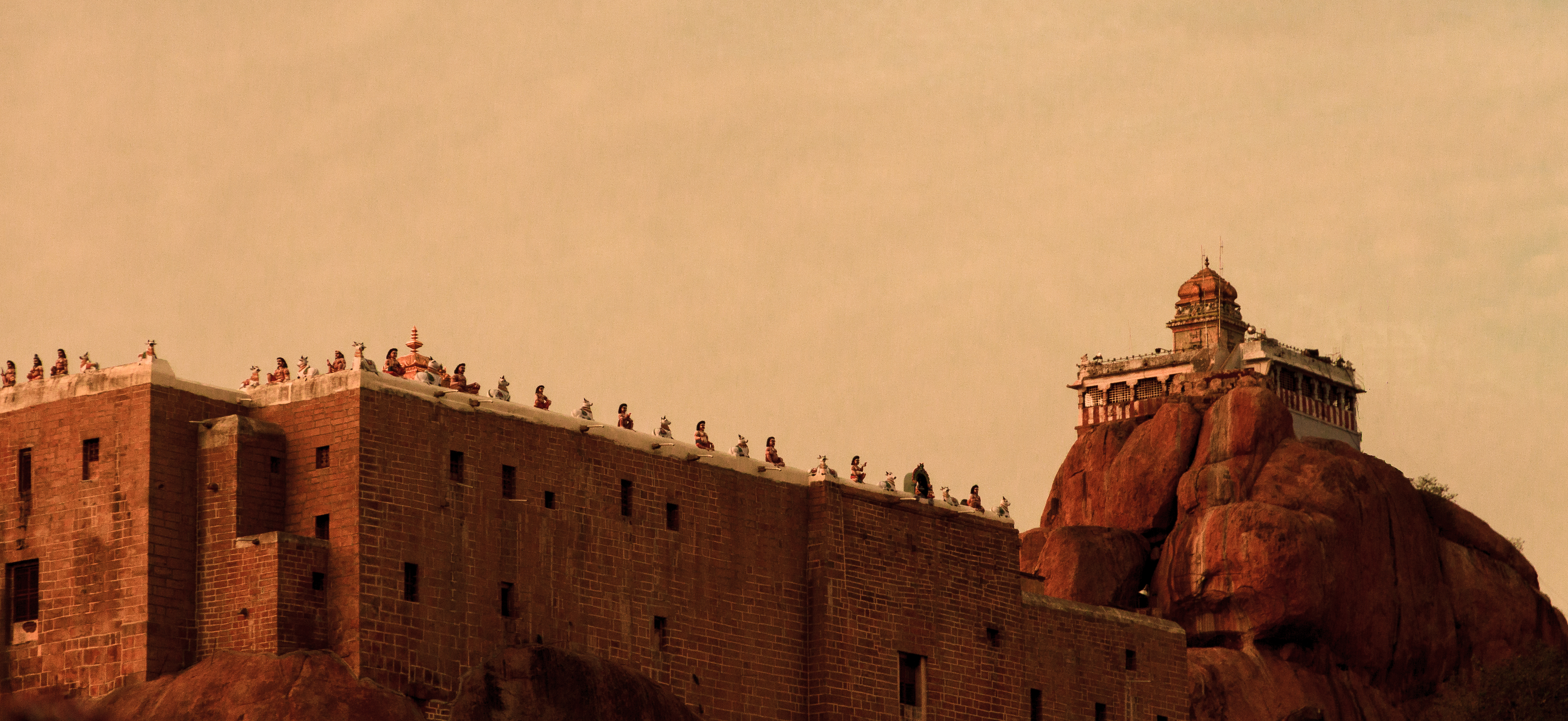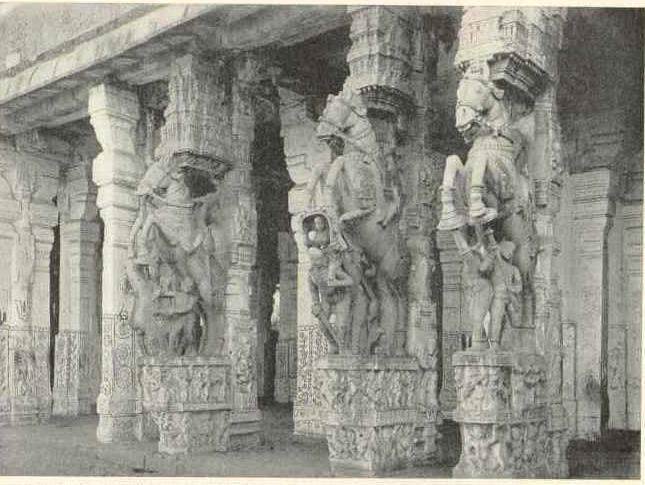|
Tiruchirapalli Rock Fort
Tiruchirappalli Rockfort, locally known as Malaikottai, is a historic fortification and temple complex built on an ancient rock. It is located in the city of Tiruchirappalli, on the banks of river Kaveri, Tamil Nadu, India. It is constructed on an high rock.India By Sarina Singh, Joe Bindloss, Paul Clammer, Janine Eberle There are two Hindu temples inside, the Ucchi Pillayar Temple, Rockfort and the Thayumanaswami Temple, Rockfort. Other local tourist attractions include the famous Pallava-era Ganesha temple and the Madurai Nayak-era fort. The fort complex has witnessed fierce battles between the Madurai Nayakas and Adil Shahi dynasty of Bijapur, Carnatic region and Maratha Imperial forces. The fort played an important part during the Carnatic Wars, helping lay the foundations of the British Empire in India. The Rockfort is the most prominent landmark of the city. History The name "Rockfort" comes from frequent military fortification built here, first by the emperors of the ... [...More Info...] [...Related Items...] OR: [Wikipedia] [Google] [Baidu] |
Tiruchirappalli
Tiruchirappalli () ( formerly Trichinopoly in English), also called Tiruchi or Trichy, is a major tier II city in the Indian state of Tamil Nadu and the administrative headquarters of Tiruchirappalli district. The city is credited with being the best livable city and the cleanest city of Tamil Nadu, as well as the fifth safest city for women in India. It is the fourth largest city as well as the fourth largest urban agglomeration in the state. Located south of Chennai and north of Kanyakumari, Tiruchirappalli sits almost at the geographic centre of Tamil Nadu state. The Cauvery Delta begins west of the city where the Kaveri river splits into two, forming the island of Srirangam which is now incorporated into the Tiruchirappalli City Municipal Corporation. The city occupies an area of and had a population of 916,857 in 2011. Tiruchirappalli's recorded history begins in the 3rd century BC, when it was under the rule of the Cholas. The city has also been ruled by the Pall ... [...More Info...] [...Related Items...] OR: [Wikipedia] [Google] [Baidu] |
Maratha Empire
The Maratha Empire, also referred to as the Maratha Confederacy, was an early modern Indian confederation that came to dominate much of the Indian subcontinent in the 18th century. Maratha rule formally began in 1674 with the coronation of Shivaji of the Bhonsle, Bhonsle Dynasty as the ''Chhatrapati'' (Marathi language, Marathi: "The title "Chhatrapati" was created by Shivaji upon his coronation"). Although Shivaji came from the Maratha_(caste), Maratha caste, the Maratha empire also included warriors, administrators and other notables from Maratha and several other castes from Maharashtra. They are largely credited for ending the Mughal Empire, Mughal control over the Indian subcontinent and establishing the Maratha Empire. The religious attitude of Aurangzeb, Mughal Emperor Aurangzeb estranged non-Muslims, and his inability to finish the resulting Maratha uprising after a Mughal–Maratha Wars, 27-year war at a great cost to his men and treasure, eventually ensued Maratha a ... [...More Info...] [...Related Items...] OR: [Wikipedia] [Google] [Baidu] |
Kingdom Of Mysore
The Kingdom of Mysore was a realm in South India, southern India, traditionally believed to have been founded in 1399 in the vicinity of the modern city of Mysore. From 1799 until 1950, it was a princely state, until 1947 in a subsidiary alliance with Presidencies and provinces of British India, British India. The British took Direct Control over the Princely state, Princely State in 1831.Rajakaryaprasakta Rao Bahadur (1936), p383 It then became Mysore State (later enlarged and renamed to Karnataka) with its ruler remaining as Rajapramukh until 1956, when he became the first Governor of the reformed state. The kingdom, which was founded and ruled for most part by the Hindu Wodeyar family, initially served as feudatories under the Vijayanagara Empire. The 17th century saw a steady expansion of its territory and during the rule of Kanthirava Narasaraja I, Narasaraja Wodeyar I and Chikka Devaraja, Chikka Devaraja Wodeyar, the kingdom annexed large expanses of what is now southern ... [...More Info...] [...Related Items...] OR: [Wikipedia] [Google] [Baidu] |
Thanjavur Maratha Kingdom
The Thanjavur Maratha kingdom ruled by the Bhonsle dynasty was a principality of Tamil Nadu between the 17th and 19th centuries. Their native language was Marathi. Venkoji was the founder of the dynasty. Maratha conquest of Thanjavur Following the demise of Chola rule in the 13th century (specifically around 1279), the Thanjavur area came under the rule of the Pandyas and then, following the invasion of Malik Kafur, it fell into disorder. Pandya nadu very quickly reasserted their independence and added Thanjavur to their domain. Soon afterwards, however, they were conquered by the Vijayanagara Empire. The Emperor appointed his trusted Kin, who belonged to the Telugu Balija caste as Governors (Nayakas) of Madurai and Tanjavur. An internal family squabble between Chokkanatha Nayak of Madurai Nayak dynasty and his uncle Vijayaraghava Nayaka of Tanjavur led to a war and eventually ended in the defeat of Thanjavur. The rule of the Thanjavur Nayaks lasted until 1673, when Cho ... [...More Info...] [...Related Items...] OR: [Wikipedia] [Google] [Baidu] |
Thanjavur Nayak Kingdom
The Thanjavur Nayak kingdom or Thanjavur Nayak dynasty were the rulers of Thanjavur in the 15th and 17th centuries. The Nayaks of the Balija social group, were originally appointed as provincial governors by the Vijayanagara Emperor in the 15th century, who divided the territory into Nayak kingdoms which were Madurai, Tanjore, Gingee and Kalahasthi. In the mid 15th century they became an independent kingdom, although they continued their alliance with the Vijayanagara Empire. The Thanjavur Nayaks were notable for their patronage of literature and the arts. A translation from '' Raghunathabhyudayam (p. 284)'', says this about Timma Nayak the father of Sevappa Nayak, the founder of the Tanjore Nayak in line: ''In the sathria caste born from the feet of Vishnu was born a king called Timma Nayak''.''Nayaks of Tanjore'', by V. Vriddhagirisan, p.26 The ''Mannaru'' (Vishnu) of the Mannargudi temple was their ''kula daivam'' (family deity). Origins of Nayak rule With the demise of the ... [...More Info...] [...Related Items...] OR: [Wikipedia] [Google] [Baidu] |
Thanjavur
Thanjavur (), also Tanjore, Pletcher 2010, p. 195 is a city in the Indian state of Tamil Nadu. Thanjavur is the 11th biggest city in Tamil Nadu. Thanjavur is an important center of South Indian religion, art, and architecture. Most of the Great Living Chola Temples, which are UNESCO World Heritage Monuments, are located in and around Thanjavur. The foremost among these, the Brihadeeswara Temple, is located in the centre of the city. Thanjavur is also home to Tanjore painting, a painting style unique to the region. Thanjavur is the headquarters of the Thanjavur District. The city is an important agricultural centre located in the Kaveri Delta and is known as the ''Rice bowl of Tamil Nadu''. Thanjavur is administered by a municipal corporation covering an area of and had a population of 290,720 in 2011. Roadways are the major means of transportation, while the city also has rail connectivity. The nearest airport is Tiruchirapalli International Airport, located away from th ... [...More Info...] [...Related Items...] OR: [Wikipedia] [Google] [Baidu] |
Aravidu Dynasty
The Aravidu Dynasty was the fourth and last Hindu dynasty of Vijayanagara Empire in South India. Its founder was Tirumala Deva Raya, whose brother Rama Raya had been the masterful regent of the last ruler of the previous dynasty. Rama Raya's death at the Battle of Talikota in 1565 led to the subsequent destruction of Vijayanagar by the combined forces of the Muslim states of the Deccan. The Aravidu family claimed to be Kshatriyas and were based in Andhra region They claimed to belong to the Atreya gotra and traced their lineage to Rajaraja Narendra. List of rulers The main rulers of the Aravidu dynasty were: *Aliya Rama Raya (1542–1565 CE), first ruler *Tirumala Deva Raya (1565–1572 CE) *Sriranga Deva Raya (Sriranga I) (1572–1586 CE) *Venkatapati Deva Raya (Venkata II) (1586–1614 CE) *Sriranga II (1614–1617 CE) *Rama Deva Raya (1617–1632 CE) *Peda Venkata Raya (Venkata III) (1632–1642 CE) *Sriranga III (1642–1652 CE), last ruler of dynasty and empire See also ... [...More Info...] [...Related Items...] OR: [Wikipedia] [Google] [Baidu] |
Kingdom Of France
The Kingdom of France ( fro, Reaume de France; frm, Royaulme de France; french: link=yes, Royaume de France) is the historiographical name or umbrella term given to various political entities of France in the medieval and early modern period. It was one of the most powerful states in Europe since the High Middle Ages. It was also an early colonial power, with possessions around the world. France originated as West Francia (''Francia Occidentalis''), the western half of the Carolingian Empire, with the Treaty of Verdun (843). A branch of the Carolingian dynasty continued to rule until 987, when Hugh Capet was elected king and founded the Capetian dynasty. The territory remained known as ''Francia'' and its ruler as ''rex Francorum'' ("king of the Franks") well into the High Middle Ages. The first king calling himself ''rex Francie'' ("King of France") was Philip II, in 1190, and officially from 1204. From then, France was continuously ruled by the Capetians and their cadet lin ... [...More Info...] [...Related Items...] OR: [Wikipedia] [Google] [Baidu] |
South India
South India, also known as Dakshina Bharata or Peninsular India, consists of the peninsular southern part of India. It encompasses the Indian states of Andhra Pradesh, Karnataka, Kerala, Tamil Nadu, and Telangana, as well as the union territories of Lakshadweep and Puducherry, comprising 19.31% of India's area () and 20% of India's population. Covering the southern part of the peninsular Deccan Plateau, South India is bounded by the Bay of Bengal in the east, the Arabian Sea in the west and the Indian Ocean in the south. The geography of the region is diverse with two mountain ranges – the Western and Eastern Ghats – bordering the plateau heartland. The Godavari, Krishna, Kaveri, Tungabhadra, Periyar, Bharathappuzha, Pamba, Thamirabarani, Palar, and Vaigai rivers are important perennial rivers. The majority of the people in South India speak at least one of the four major Dravidian languages: Tamil, Telugu, Malayalam and Kannada (all 4 of which are among the 6 Classic ... [...More Info...] [...Related Items...] OR: [Wikipedia] [Google] [Baidu] |
Malik Kafur
Malik Kafur (died 1316), also known as Taj al-Din Izz al-Dawla, was a prominent slave-general of the Delhi Sultanate ruler Alauddin Khalji. He was captured by Alauddin's general Nusrat Khan during the 1299 invasion of Gujarat, and rose to prominence in the 1300s. As a commander of Alauddin's forces, Kafur defeated the Mongol invaders in 1306. Subsequently, he led a series of expeditions in the southern part of India, against the Yadavas (1308), the Kakatiyas (1310), the Hoysalas (1311), and the Pandyas (1311). From these campaigns, he brought back many treasures, and many elephants and horses for the Delhi Sultanate. From 1313 to 1315, Kafur served as Alauddin's governor of Devagiri. When Alauddin fell seriously ill in 1315, Kafur was recalled to Delhi, where he exercised power as ''Na'ib'' (viceroy). After Alauddin's death, he tried to usurp control by appointing Alauddin's minor son, Shihabuddin Omar, as a puppet monarch. Kafur's regency lasted for about a month, before he ... [...More Info...] [...Related Items...] OR: [Wikipedia] [Google] [Baidu] |
Delhi Sultanate
The Delhi Sultanate was an Islamic empire based in Delhi that stretched over large parts of the Indian subcontinent for 320 years (1206–1526).Delhi Sultanate Encyclopædia Britannica Following the invasion of by the , five dynasties ruled over the Delhi Sultanate sequentially: the Mamluk dynasty (1206–1290), the Khalji dynasty (1290–1320), the |






